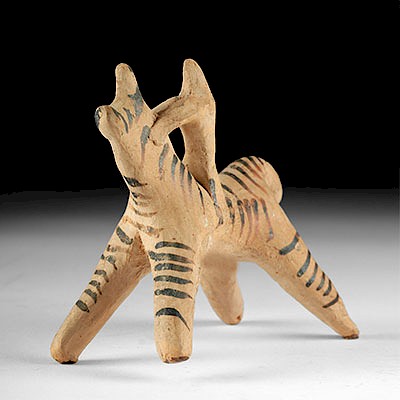Chinese Han Dynasty Blackware Amphora
Lot 155
About Seller
Artemis Fine Arts
686 S Taylor Ave, Ste 106
Louisville, CO 80027
United States
Selling antiquities, ancient and ethnographic art online since 1993, Artemis Gallery specializes in Classical Antiquities (Egyptian, Greek, Roman, Near Eastern), Asian, Pre-Columbian, African / Tribal / Oceanographic art. Our extensive inventory includes pottery, stone, metal, wood, glass and textil...Read more
Categories
Estimate:
$1,200 - $1,800
Absentee vs Live bid
Two ways to bid:
- Leave a max absentee bid and the platform will bid on your behalf up to your maximum bid during the live auction.
- Bid live during the auction and your bids will be submitted real-time to the auctioneer.
Bid Increments
| Price | Bid Increment |
|---|---|
| $0 | $25 |
| $300 | $50 |
| $1,000 | $100 |
| $2,000 | $250 |
| $5,000 | $500 |
| $10,000 | $1,000 |
| $20,000 | $2,500 |
| $50,000 | $5,000 |
| $100,000 | $10,000 |
| $200,000 | $20,000 |
About Auction
By Artemis Fine Arts
Oct 25, 2018
Set Reminder
2018-10-25 11:00:00
2018-10-25 11:00:00
America/New_York
Bidsquare
Bidsquare : Antiquities from Egypt, Greece, Italy, Asia
https://www.bidsquare.com/auctions/artemis-gallery/antiquities-from-egypt-greece-italy-asia-3538
Featuring Egyptian, Greek, Roman, Etruscan, Near Eastern, plus Asian art from Central and Far East. If you love the classics, this is the sale for you. Artemis Fine Arts info@artemisfinearts.com
Featuring Egyptian, Greek, Roman, Etruscan, Near Eastern, plus Asian art from Central and Far East. If you love the classics, this is the sale for you. Artemis Fine Arts info@artemisfinearts.com
- Lot Description
East Asia, China, Han Dynasty, ca. 206 BCE to 220 CE. A black earthenware vessel of an incredibly distinctive form with a slightly-inset ring base, a round yet four-sided body, a tapered neck with raised vertical ridges, a flared rim, and a pair of applied strap handles joining rim to body. Each of the body's four sides bears a series of raised swirls. A lovely example of a unique pottery type from ancient China! Size: 7.3" W x 7.5" H (18.5 cm x 19 cm)
This type of double-handled amphora was made in western Sichuan province, in central China, and is known as "Lifan" after the area where vessels like it are found. The style is fascinating, very different from others created during the Han period, and seems to be an artistic callback to the elegant forms of the Chinese Neolithic era. These vessels are found mainly within rock-cut tombs and cist burials, with a few examples known from the more classically Han chambered brick tombs. This suggests that these vessels were made by immigrants or members of non-dominant ethnic groups within Han China, probably people who lived a nomadic lifestyle centered on husbandry while their Chinese contemporaries led more sedentary, agricultural-based lifestyles.
Provenance: ex-Lotus Trading Company, Hong Kong, China, brought to the US around 1975
All items legal to buy/sell under U.S. Statute covering cultural patrimony Code 2600, CHAPTER 14, and are guaranteed to be as described or your money back.
A Certificate of Authenticity will accompany all winning bids.
We ship worldwide and handle all shipping in-house for your convenience.
#138065Surface wear and abrasions commensurate with age and use, minor nicks to handles, rim, body, and base, otherwise intact and very good.Condition
- Shipping Info
-
All shipping is handled in-house for your convenience. Your invoice from Artemis Gallery will include shipping calculation instructions. If in doubt, please inquire BEFORE bidding for estimated shipping costs for individual items.
-
- Buyer's Premium



 EUR
EUR CAD
CAD AUD
AUD GBP
GBP MXN
MXN HKD
HKD CNY
CNY MYR
MYR SEK
SEK SGD
SGD CHF
CHF THB
THB
















